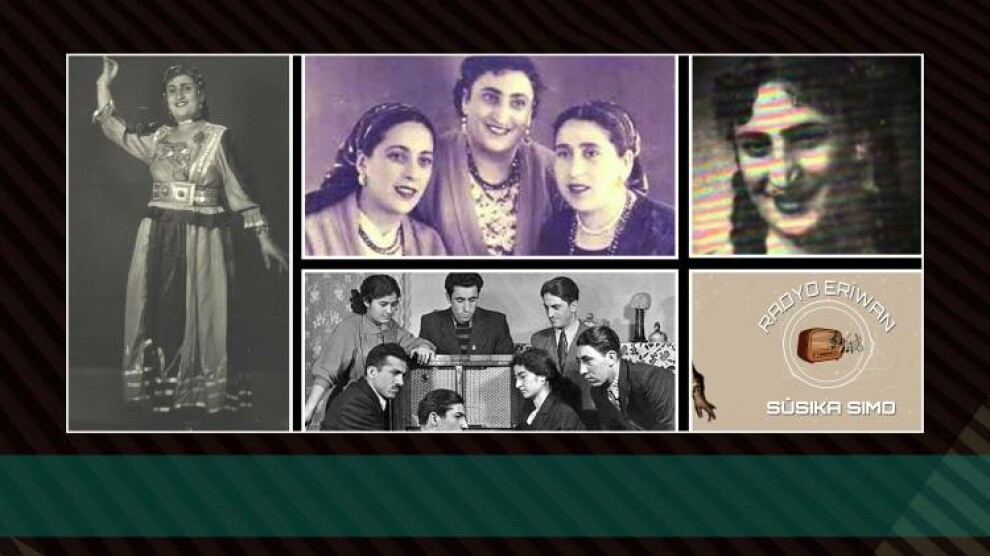Memory of Kurdish culture: Dengbêj-2
Sûsika Simo: A Dengbêj without borders Sûsika Simo was a female dengbêj, whose Kurdish and Armenian songs were listened to in many countries through Radio Yerevan.

Sûsika Simo: A Dengbêj without borders
Sûsika Simo was a female dengbêj, whose Kurdish and Armenian songs were listened to in many countries through Radio Yerevan.
News Center- Sûsika Simo was born in 1925 in the village of Mîrekêda in the Elegez region of Armenia as a daughter of a refugee Kurdish and Yazidi family. Her family moved to Gyumri when she was a child and she started going to school there. Being born and growing up during the Soviet Union, Sûsika Simo studied medicine and she began to work as a doctor in Georgia. But Sûsika Simo had a non-stop rhythm in her. That rhythm wanted to be heard and it soon made Sûsika Simo to leave her job at the hospital and follow it. She followed that rhythm and the tradition of Dengbêj in the feudal structure of society. In 1946, at the age of 21, she took the stage and sang Kurdish and Armenian songs.
Sûsika Simo took the stage at Red Square
Her love for the tradition of Dengbêj and her self-confidence allowed her to be known. The employees of Radio Yerevan offered her to work with them. She accepted to work with them and began to sing songs as a dengbêj for the radio in 1955. Sûsika Simo worked with Egîdê Cimo in the cultural programs of the radio. Egîdê Cimo was a kaval player (end-blown flute) and known as “kavalın miri (the master of kaval)”. Egîdê Cimo played his kaval while Sûsika Simo sang songs. “Evdale Zeynike” and “Xerîb Bilbil” are two songs she sang. Sûsika Simo gave many concerts at Red Square. She was a socialist.
Shining star from the Soviet Union
Sûsika Simo got known in time. She met Armenian athlete Kulya Neftalyan and they fell in love. Getting married to someone, not from her ethnic background caused the reaction. But she never listened to anyone for her love and she got married Kulya Neftalyan. At that time, she worked with Egîdê Cimo and her husband Kulya Neftalyan. Sûsika Simo became known not only in Armenia but also in many Soviet countries. Her husband Kulya Neftalyan always supported her. They didn’t have a child and they dedicated their lives to art.
Her voicelistened to in many countries
Sûsika Simo always wore Kurdish traditional dresses and kofi (a kind of hat worn by Kurdish women) whenever she took the stage. Sûsika Simo formed two musical groups and she also worked with a theatre group called Elegez. She introduced the Kurdish culture in the Caucasus with her songs. She made a contribution to Kurdish classical music by composing dozens of songs. Her voice was listened to by millions. Sûsika Simo also liked halay and she danced halay very well. She was also called, “Gula Govende (the rose of halay).
Many articles about her
Writer Wezîrê Eşo published an article titled, “Bizim Sûsik (Our Sûsik) for the “Riya Teze” newspaper and he wrote about how the voice of Sûsika Simo was good. “Don't imagine her like a traditional woman. Her performance on stage makes a hit. Her musical experience and her magnificent stage performance allow her to be known not only in Yerevan but also in the Caucasus in a short time. Sûsika Simo existed before Radio Yerevan and she will always exist,” Wezîrê Eşo wrote in his article.
She left her dresses and voice
Sûsika Simo was born as a refugee child and grew up during the October Revolution. She died in 1977, Yerevan, and she was buried in Gyumri. She left her traditional dresses and voice behind. Her voice was listened to by the Kurds living around the world through Radio Yerevan. “Lenînê Mezin (Great Lenin)” is one of the most known songs.
Tomorrow: Fatma İsa: The dengbêj of all time
